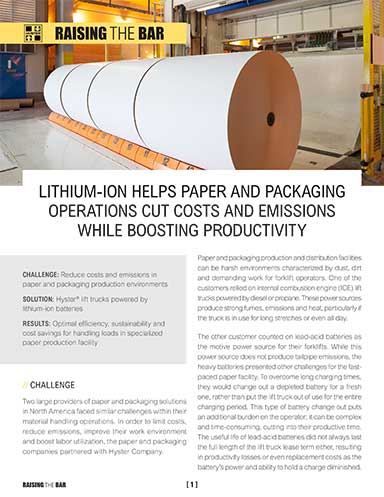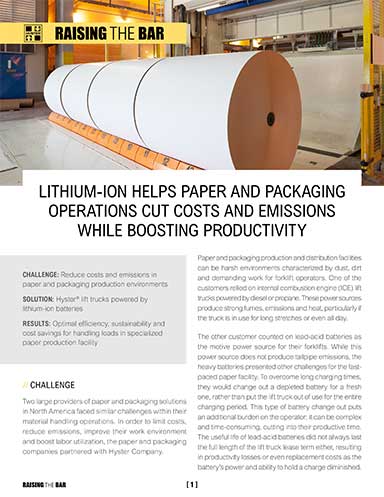Digitization of Warehouse Equipment Maintenance
Maintenance is rapidly evolving toward a digital point, starting with training and extending all the way to well-maintained equipment.
Not to make too much of this, but there’s something going on in the digitization of maintenance. And it has some parallels to 2007, which was a big deal in the digital world.
That was when Apple launched the iPhone, Facebook and Twitter went global, Amazon released the Kindle, and the Cloud fell to earth. Not a bad year. But it wasn’t just the tech itself that was so important.
These advances (and others) changed our lives because they were all way more interconnected than we ever imagined possible. Even the great recession in 2008 did nothing to derail any of those trends. Thomas Friedman published a book about it all called “Thank You for Being Late” in 2016.
Similarly in 2020, remote learning tools, augmented/virtual reality, tablets, smart glasses and more are emerging as the next leg in the move to digitization of maintenance from training to repairs. The pandemic is proving to be a strong catalyst, too. Meanwhile, the economy is really rough, yet seemingly encouraging maintenance’s move to digital with an eye on speed and cost effectiveness.
John Rosenberger of The Raymond Corp:
“We are breaking through the inertia of ‘can digital work in maintenance’ to ‘this works really well, let’s go.’”
Digital Training
To be fair, 2007 didn’t just happen. All those milestones were years in the making, just like what’s happening now in maintenance.
While the scale of what happened in the 2007 big picture dwarfs maintenance in 2020, the implications are the same. Specifically, digital tools and abundant interconnectedness are changing their respective worlds.
Let’s start at the beginning: maintenance training. Digital training is not new to materials handling. Augmented reality (AR)/virtual reality (VR) has been used for some time to train lift truck operators. In 2015, Forklift Simulator received an Innovation Award from MHI at ProMat for its VR training program. And since then, an estimated 10,000 operators have undergone various flavors of AR/VR training.
Bram Clincke is the founder of Forklift Simulator, the first of the digital training platforms for lift truck operators. He sees an easy migration of AR and VR technologies to maintenance tech training. The subjects may be different, he says, but the underpinning basics of how people learn are not.
Quite simply, they are both highly immersive and rely on game learning to motivate and speed along students’ understanding of the subject.
Bram Clincke adds:
“Students love to see how they compare against other students. This competition not only helps them to learn specific skills more quickly, but encourages them to find better ways to perform tasks.”
It’s worth noting that Clincke does not get hung up on the use of augmented versus virtual reality. While the two offer a different experience to the student, Clincke expects them to merge in the next couple of years, creating an even more enhanced immersive learning experience.
Perhaps just as important, Clincke is not alone in seeing a digital path for training. Consultants PwC and Intel, to name two, have recently released studies on the value of digital training of techs.
PwC expects overall VR training to be worth nearly $300 billion in 10 years. Meanwhile, it cites “improvements in process efficiency” in using VR to train maintenance techs.
Intel cites three enterprise benefits to digital training:
- Reduces training total cost of ownership,
- Increases trainee retention and motivation, and
- Increases training return on investment.
At this point, Raymond, Hyster and others are already using some form of digital training for techs. It’s important to note that digital is not replacing hands-on training. The common estimate is that digital accounts for as much as 80% of training with the balance being hands on.
Over at Hyster, Pat DeSutter, the company’s vice president of fleet service and aftermarket, sees a pivot to digital training of techs. He cites few barriers to using digital technologies and increased acceptance by all.
“In addition to virtual classroom settings, the shift to more remotely supported, live-case, visual-based training is highly advantageous to the learning experience.”
Rod Payne, regional parts service manager for Raymond dealer Associated:
“Digital training has taken off in the past three to four months due to Covid. You could say the five-year plan for the shift to digital tech training happened in March. This is a sustainable change going from 95% in-person training to primarily virtual. I didn’t expect it to happen so quickly. I wasn’t even sold on it in the first place.”
It’s worth noting, says Rosenberger, Raymond’s director of iWarehouse Gateway and global telematics, that AR is not all there is to digital training.
“People tend to focus on the goggles, but there are also tablets, YouTube videos and other accessories that are part of the digital training of techs. And, it can all be done remotely as needed because the training systems are so interconnected.”
Rosenberger also notes that digital training does not generally have an age divide in it. “People of all ages are adapting to it. Gamification and who completes the course first appeals to everyone, not just younger people,” he explains.
Similarly, lift truck techs are not the only ones benefiting from digital training. System techs including ones who work on automated equipment are part of the mix, too, says Kevin Reader, director of business development and marketing at Knapp.
Digital Maintenance
Then there’s the matter of digital aids that facilitate activities at the point of maintenance in a timely manner.
David Krebs, vice president of research at analyst firm VDC Research:
“Meeting today’s customer service requirements places a premium on communication and transparency. “Gone are the days of four-hour service windows. Customers expect omni-channel communications options and greater visibility into their service lifecycle.”
That’s the big picture. There’s also a significant change at the site of needed maintenance. Quite simply, digitization is literally bringing all needed expertise right to that point.
Traditionally, techs have been on their own when working on, say, a motor powering tilt-tray sorter No. 1. Digitization changes that. While only one person might be in front of that motor, an entire team of experts can provide remote support.
There are two components here. One is information about the condition of that motor. The other is on-site maintenance tools such as smart glasses, tablets and even smart phones.
The real interconnectedness of the maintenance operation relies on advanced data capture about equipment condition and the ability to feed that information directly to techs, explains Reader of Knapp.
For instance, sensors collect data showing the motor is running hot. This allows a tech to visit the motor right now and determine the appropriate maintenance action, often with the help of smart glasses.
Glasses usually combine a video camera, microphone, AR capabilities and even a bar code scanner. As Honeywell Intelligrated spokesman Whitney Ellis says, smart glasses are more than just a second set of eyes for on-site techs. They make possible real-time problem diagnosis and issue resolution with the help of service experts located remotely. In addition, data including schematics, videos and even augmented reality views can be delivered directly to the smart glasses, guiding the on-site tech, expediting the repair.
These platforms can connect to servers receiving telematics data on a particular lift truck’s operation. That information might trigger a need for a maintenance tech’s attention to lift truck No. 24. Or, the facility’s operation manager may have noticed a problem and can notify maintenance of a problem with a simple smart phone app. Working on the truck, the tech can access key information on a tablet to help guide the repair.
Stachler:
“This is connected maintenance. It combines preventative maintenance, proactive dispatch and even wireless software updates. It truly illustrates the potential of the connected forklift as these systems continue to become more integrated.”
Hyster’s DeSutter:
“Connectivity is the key. A foundational service platform gathers data on the asset, develops an enterprise view of the fleet and how it needs to be serviced for maximum effectiveness out on the floor.”
In other words, there are not only plenty of moving parts on a truck, but the fleet itself is made up of many moving parts, making connectivity a critical enabler.
Like Reader, Rosenberger is quick to point to all the data available directly from the equipment as it operates. “With advanced telematics, today’s lift truck is an information conduit about itself. Trucks themselves are smarter and share that data in real time,” Rosenberger adds.
He also points out that data is just data. It needs to be converted into information to effectively support the maintenance function. “And, yes, there is a direct correlation between that information and the effectiveness of the tech on the job,” says Rosenberger. That’s true for lift trucks and big, automated systems.
Yes, we are in the early stages now. But watch out. As DeSutter says:
“Maintenance connectivity is table stakes going forward. With the advent of digital, the maintenance paradigm has already changed forever.”
Related White Papers
Cut Total Cost of Ownership by Monitoring Operational Data
Today's telematics and fleet management tools allow lift truck owners to accurately monitor and measure truck data to make operational decisions that improve maintenance, reduce energy cost and maximize operator productivity—all resulting in a lower total cost of ownership. Download Now!
Article Topics
Hyster News & Resources
Hyster-Yale Group provides students with real-world AI experience in 2024 Kellogg Design Challenge Hyster recognizes Dealers of Distinction for 2023 Learn from lift truck service history Leasing’s fleet management upside Autonomous lift trucks emerge Autonomous Lift Trucks Emerge Enersys integrates its TPPL technology with Yale Power Key and Hyster Power Cellect More HysterLatest in Warehouse|DC
The Rise of the Stanley Cup: A Supply Chain Challenge GXO Logistics Deploys 500 Robots for Top Sporting Goods Retailer UPS Cuts Email Response Time in Half with AI Automation Cambium is on a Quest to Breathe New Life Into Old Wood Record High in Container Production Expected for 2024 IBM Investing $730 million to Expand Semiconductor Plant in Canada Indiana Tests Futuristic Highway that Can Charge EVs While Driving More Warehouse|DC














